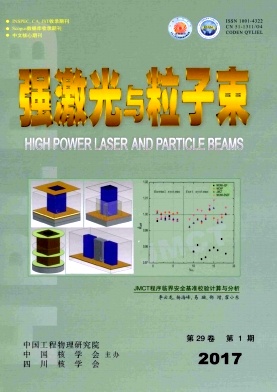2017 Vol. 29, No. 01
Recommend Articles
Display Method:
2017,
29: 016001.
doi: 10.11884/HPLPB201729.160176
Abstract:
In the fast reactor analysis, one of the most important things is generation of homogenized cross sections starting from the evaluated nuclear data files. By using point-wise cross section directly during the generation of problem dependent ultrafine...
In the fast reactor analysis, one of the most important things is generation of homogenized cross sections starting from the evaluated nuclear data files. By using point-wise cross section directly during the generation of problem dependent ultrafine...
2017,
29: 016002.
doi: 10.11884/HPLPB201729.160181
Abstract:
The reactor reloading pattern optimization is a typical combinatorial optimization problem with a huge search space. It is very hard for traditional optimization algorithm to find the global optimal solution in such huge search space. However, for co...
The reactor reloading pattern optimization is a typical combinatorial optimization problem with a huge search space. It is very hard for traditional optimization algorithm to find the global optimal solution in such huge search space. However, for co...
2017,
29: 016003.
doi: 10.11884/HPLPB201729.160190
Abstract:
RMC is a self-developed Monte Carlo software for nuclear reactor analysis by Reactor Engineering Analysis Lab(REAL), Tsinghua University. On the basis of the self-developed subchannel modular(RMC-TH) and Monte Carlo CellTally the inner coupling inter...
RMC is a self-developed Monte Carlo software for nuclear reactor analysis by Reactor Engineering Analysis Lab(REAL), Tsinghua University. On the basis of the self-developed subchannel modular(RMC-TH) and Monte Carlo CellTally the inner coupling inter...
2017,
29: 016004.
doi: 10.11884/HPLPB201729.160199
Abstract:
The optimization of the core periodical physical flux map test could be done using the SOPHORA on-line core monitoring system developed by China General Nuclear Power Group. This system can perform the calculation of 3D online monitoring, core operat...
The optimization of the core periodical physical flux map test could be done using the SOPHORA on-line core monitoring system developed by China General Nuclear Power Group. This system can perform the calculation of 3D online monitoring, core operat...
2017,
29: 016005.
doi: 10.11884/HPLPB201729.160200
Abstract:
A new on-line core monitoring software system (CMSS), named SOPHORA, is developed by China General Nuclear Power Corporation (CGN). Based on the measured fixing incore detector (FID) readings and on-line core status parameters, the best estimated 3D ...
A new on-line core monitoring software system (CMSS), named SOPHORA, is developed by China General Nuclear Power Corporation (CGN). Based on the measured fixing incore detector (FID) readings and on-line core status parameters, the best estimated 3D ...
2017,
29: 016006.
doi: 10.11884/HPLPB201729.160208
Abstract:
Considering that the conventional Bondarenko-Iteration Method (BIM) would introduce much error in treating resonance interference effect, the Resonance-Interference-Factor Method (RIFM) and the Heterogeneous-Pseudo-Resonant-Isotope Method (HPRIM) was...
Considering that the conventional Bondarenko-Iteration Method (BIM) would introduce much error in treating resonance interference effect, the Resonance-Interference-Factor Method (RIFM) and the Heterogeneous-Pseudo-Resonant-Isotope Method (HPRIM) was...
2017,
29: 016007.
doi: 10.11884/HPLPB201729.160212
Abstract:
JMCT developed by Institute of Applied Physics and Computational Mathematics is a transport code based on Monte Carlo method. A series of benchmark experiments picked up from the international nuclear critical experiment database, were used to valida...
JMCT developed by Institute of Applied Physics and Computational Mathematics is a transport code based on Monte Carlo method. A series of benchmark experiments picked up from the international nuclear critical experiment database, were used to valida...
2017,
29: 016009.
doi: 10.11884/HPLPB201729.160226
Abstract:
Measurements of in-core detectors, as one of the most important inputs for a reactor core on-line power distribution monitoring system, seriously affect the on-line monitoring results. Therefore, the diagnosis and processing of detector failure are n...
Measurements of in-core detectors, as one of the most important inputs for a reactor core on-line power distribution monitoring system, seriously affect the on-line monitoring results. Therefore, the diagnosis and processing of detector failure are n...
2017,
29: 016008.
doi: 10.11884/HPLPB201729.160221
Abstract:
CTF (Coolant Boiling in Rod Arrays-Two Fluid) is a new sub-channel thermal/hydraulic simulation code developed by CASL (The Consortium for Advanced Simulation of Light Water Reactors) and PSU (Pennsylvania State University). It can solve steady or tr...
CTF (Coolant Boiling in Rod Arrays-Two Fluid) is a new sub-channel thermal/hydraulic simulation code developed by CASL (The Consortium for Advanced Simulation of Light Water Reactors) and PSU (Pennsylvania State University). It can solve steady or tr...
2017,
29: 016010.
doi: 10.11884/HPLPB201729.160235
Abstract:
The program of nuclear medical ship, funded by the cancer healing program of IAEA, was proposed according to the existing Miniature Neutron Source Reactor (MNSR) technology. The nuclear medical ship equipped with Boron Neutron Capture Therapy(BNCT) d...
The program of nuclear medical ship, funded by the cancer healing program of IAEA, was proposed according to the existing Miniature Neutron Source Reactor (MNSR) technology. The nuclear medical ship equipped with Boron Neutron Capture Therapy(BNCT) d...
2017,
29: 016011.
doi: 10.11884/HPLPB201729.160238
Abstract:
Compared with conservative accident analysis method, best estimate plus uncertainty (BEPU) accident analysis method can gain realistic analysis results and safety margins, and improve the nuclear power plant economy and flexibility of operation with ...
Compared with conservative accident analysis method, best estimate plus uncertainty (BEPU) accident analysis method can gain realistic analysis results and safety margins, and improve the nuclear power plant economy and flexibility of operation with ...
2017,
29: 016012.
doi: 10.11884/HPLPB201729.160243
Abstract:
The three dimension multi-group neutron transport Monte-Carlo program MCMG-Ⅱ and the multi-group point burnup program STEP1.0 based on linear chain method are adopted in the transport-burnup coupling system. The coupling information between the burnu...
The three dimension multi-group neutron transport Monte-Carlo program MCMG-Ⅱ and the multi-group point burnup program STEP1.0 based on linear chain method are adopted in the transport-burnup coupling system. The coupling information between the burnu...
2017,
29: 016013.
doi: 10.11884/HPLPB201729.160260
Abstract:
A tightly coupled multi-physics model for molten salt reactor(MSR) system involving the reactor core and the rest of the primary loop has been developed and employed in an in-house developed computer code TANG-MSR. In this paper, the computer code is...
A tightly coupled multi-physics model for molten salt reactor(MSR) system involving the reactor core and the rest of the primary loop has been developed and employed in an in-house developed computer code TANG-MSR. In this paper, the computer code is...
2017,
29: 016014.
doi: 10.11884/HPLPB201729.160261
Abstract:
Core layout and depletion features of thorium molten salt reactor(TMSR) are analyzed using the self-developed lattice and core code SONG/TANG-MSR. Based on the results of previous lattice optimization research, fuel salt that contains no BeF2 is adop...
Core layout and depletion features of thorium molten salt reactor(TMSR) are analyzed using the self-developed lattice and core code SONG/TANG-MSR. Based on the results of previous lattice optimization research, fuel salt that contains no BeF2 is adop...
2017,
29: 016015.
doi: 10.11884/HPLPB201729.160264
Abstract:
Based on comprehensive screening, lattice parameters including fuel composition, moderator material, lattice size and structure are redesigned for thorium molten salt reactor (TMSR) applying SONG/TANG-MSR codes. Innovatively, a fuel composition witho...
Based on comprehensive screening, lattice parameters including fuel composition, moderator material, lattice size and structure are redesigned for thorium molten salt reactor (TMSR) applying SONG/TANG-MSR codes. Innovatively, a fuel composition witho...
2017,
29: 016016.
doi: 10.11884/HPLPB201729.160306
Abstract:
In order to simulate the complex structure fuel assembly, Nuclear Power Institute of China(NPIC) has developed an advanced neutron transport lattice code, named KYLIN-2. The subgroup method is adopted in KYLIN-2 to treat resonance problems. And metho...
In order to simulate the complex structure fuel assembly, Nuclear Power Institute of China(NPIC) has developed an advanced neutron transport lattice code, named KYLIN-2. The subgroup method is adopted in KYLIN-2 to treat resonance problems. And metho...
2017,
29: 016017.
doi: 10.11884/HPLPB201729.160309
Abstract:
The mechanical shim (MSHIM) operation mode and the load following technology of the large-scale passive advanced PWR core use the relevant design of the AP1000 nuclear power plant as reference, but differ from it due to its higher power and unique co...
The mechanical shim (MSHIM) operation mode and the load following technology of the large-scale passive advanced PWR core use the relevant design of the AP1000 nuclear power plant as reference, but differ from it due to its higher power and unique co...
2017,
29: 016018.
doi: 10.11884/HPLPB201729.160337
Abstract:
The development of advanced thorium-based nuclear system raises new requirements on nuclear data. The multi-group data file of critical nuclides in the thorium-uranium recycle is the foundation of physical design, analysis and calculation of the reac...
The development of advanced thorium-based nuclear system raises new requirements on nuclear data. The multi-group data file of critical nuclides in the thorium-uranium recycle is the foundation of physical design, analysis and calculation of the reac...
2017,
29: 016019.
doi: 10.11884/HPLPB201729.160334
Abstract:
Radiation heating rate is one of the important input data for the performance research, thermal hydraulic and mechanical analysis of in-core special materials such as gray rods, therefore evaluation of radiation heating rate of in-core special materi...
Radiation heating rate is one of the important input data for the performance research, thermal hydraulic and mechanical analysis of in-core special materials such as gray rods, therefore evaluation of radiation heating rate of in-core special materi...
2017,
29: 016020.
doi: 10.11884/HPLPB201729.160336
Abstract:
Compared with the 18-month refueling, 24-month fuel cycle can reduce the times of overhaul, improve the load factor, and increase generating capacity. The core cycle length in a 177 assembly PWR meets 24-month refueling requirements by increasing the...
Compared with the 18-month refueling, 24-month fuel cycle can reduce the times of overhaul, improve the load factor, and increase generating capacity. The core cycle length in a 177 assembly PWR meets 24-month refueling requirements by increasing the...
2017,
29: 016021.
doi: 10.11884/HPLPB201729.160353
Abstract:
By the linearization method, the mathematic model of point reactor can be simplified. The simplified point reactor model could be further converted to the transfer function with the Laplace transfer tool. Until now, the point reactor transfer functio...
By the linearization method, the mathematic model of point reactor can be simplified. The simplified point reactor model could be further converted to the transfer function with the Laplace transfer tool. Until now, the point reactor transfer functio...
2017,
29: 016022.
doi: 10.11884/HPLPB201729.160391
Abstract:
The boric acid concentration measured from boron meter and chemical analysis deviates from each other in the process of reactor unit operation. In this paper, we use the experimental data from QSⅡ nuclear power plant to analyze the influence of 10B a...
The boric acid concentration measured from boron meter and chemical analysis deviates from each other in the process of reactor unit operation. In this paper, we use the experimental data from QSⅡ nuclear power plant to analyze the influence of 10B a...
2017,
29: 016023.
doi: 10.11884/HPLPB201729.160411
Abstract:
This paper studies the performance analysis and design consideration of the supercritial water reactor(SCWR) fuel assembly(FA). The SCWR fuel design goal is also studied. A comparative analysis is made for different fuel assembly design on the neutro...
This paper studies the performance analysis and design consideration of the supercritial water reactor(SCWR) fuel assembly(FA). The SCWR fuel design goal is also studied. A comparative analysis is made for different fuel assembly design on the neutro...
2017,
29: 016024.
doi: 10.11884/HPLPB201729.160454
Abstract:
The JMCT software is used to calculate the gamma-ray response functions for NaI crystal. The complete process of all the photon-electron coupled transportation is simulated by JMCT. The gamma-ray energy deposition spectrum and detector response funct...
The JMCT software is used to calculate the gamma-ray response functions for NaI crystal. The complete process of all the photon-electron coupled transportation is simulated by JMCT. The gamma-ray energy deposition spectrum and detector response funct...




 Email alert
Email alert RSS
RSS

